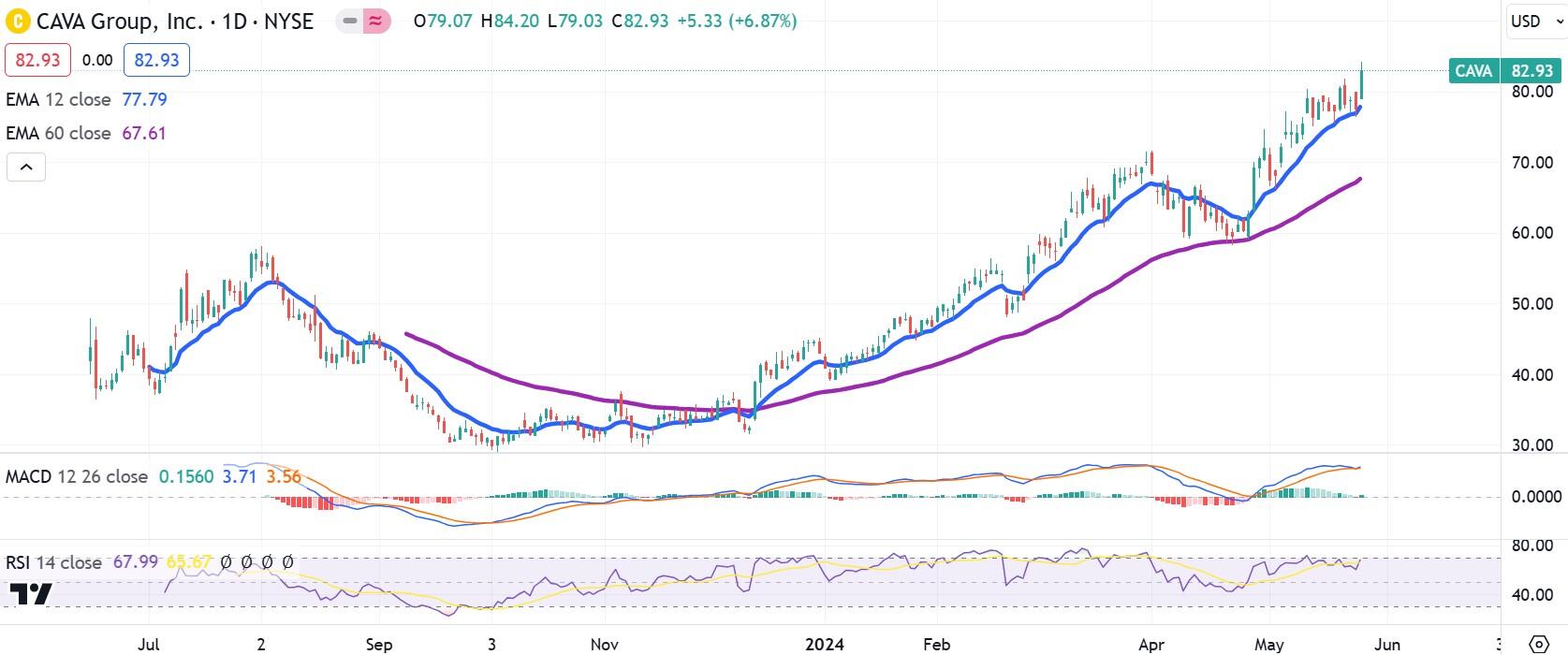- CAVA Group is a Mediterranean food chain that is expanding its location base at breakneck speed.
- CAVA Group will release first quarter results after the close on Tuesday.
- Wall Street expects $0.05 in adjusted EPS and $245.5 million in revenue.
- This compares to $0.03 in adjusted EPS in the fourth quarter on revenue of $177.2 million.
CAVA Group (CAVA) is trading at an all-time high ahead of its results release, scheduled for after market on Tuesday, May 28.
Excitement surrounds the Mediterranean chain's first-quarter results as it rapidly opens new locations across the U.S. market. The company opened 90 net new stores in the fourth quarter and is on track to open approximately 50 more in 2024.
News about CAVA shares
Wall Street expects CAVA Group to report $0.05 in adjusted earnings per share on revenue of $245.5 million. This equates to a 66% quarterly increase in EPS and a 39% quarterly increase in revenue.
The number of net new restaurants will be of great interest to those listening closely to the earnings call led by CEO Brett Schulman. Additionally, merchants will focus on profit margin at the restaurant level, which increased by 240 basis points to 22.4% of sales in the fourth quarter.
The quarter has received increasing interest as analysts have praised the company since its last earnings release in February. In the last three months, earnings estimates have been revised upward five times, and no downward revisions have been seen. Revenue estimates have seen nine upward and one downward revisions.
Argus made the first move in April when analyst Christine Dooley gave it a Buy rating and set a then-impressive price target of $70 in the recent IPO. Shares closed last Friday ahead of the Memorial Day holiday just below $83 and advanced to $84 after hours.
The company has a profitable business model, a clean balance sheet and an experienced management team,” Dooley wrote at the time.
The main sticking point for buyers is its rating, however. CAVA stock trades at 356 times forward earnings. Dooley insists these valuations are less meaningful at the beginning of a young chain's growth when profits can skyrocket overnight.
Interestingly, when UBS analysts covered the restaurant sector earlier this month, CAVA stock was rated Neutral in terms of momentum.
The S&P 500 FAQs
The S&P 500 is a widely followed stock index that measures the performance of 500 public companies and is considered a broad measure of the US stock market. The influence of each company in the calculation of the index is weighted based on market capitalization. This is calculated by multiplying the number of listed shares of the company by the share price. The S&P 500 Index has achieved impressive returns: $1.00 invested in 1970 would have produced a return of almost $192.00 in 2022. The average annual return since its inception in 1957 has been 11.9%.
Companies are selected by committee, unlike other indices where they are included based on established standards. Still, they must meet certain eligibility criteria, the most important of which is market capitalization, which must be equal to or greater than $12.7 billion. Other criteria are liquidity, domicile, market capitalization, sector, financial viability, listing time, and representation of the sectors of the United States economy. The nine largest companies in the index represent 27.8% of the index's market capitalization.
There are several ways to trade the S&P 500. Most retail brokers and spread betting platforms allow traders to use Contracts for Difference (CFDs) to place bets on price direction. In addition, you can buy index funds, mutual funds and exchange-traded funds (ETFs) that track the price of the S&P 500. The most liquid of the ETFs is the London Stock Exchange ETF. The most liquid of the ETFs is State Street Corporation's SPY. The Chicago Mercantile Exchange (CME) offers futures contracts on the index and the Chicago Board of Options (CMOE) offers options, as well as ETFs, inverse ETFs, and leveraged ETFs.
There are many factors that drive the S&P 500, but primarily it is the aggregate performance of its component companies, revealed in their quarterly and annual earnings reports. US and global macroeconomic data also contribute, influencing investor sentiment, which if positive, drives earnings. The level of interest rates, set by the Federal Reserve (Fed), also influences the S&P 500, as it affects the cost of credit, on which many companies largely depend. Therefore, inflation can be a determining factor, as well as other parameters that influence the decisions of the Federal Reserve.
CAVA Stock Forecast
Despite a near-continuous rally since last October, CAVA stock is just below overbought condition on the Relative Strength Index (RSI) at 68. The Moving Average Convergence/Divergence (MACD) indicator tells us says a bearish turn is at hand, although a rise in earnings would eliminate that possibility.
CAVA stock has been following the 12-day Exponential Moving Average (EMA) for much of its recent run, but the 60-day EMA came to the rescue during the April correction.
If the gains turn out to be lackluster, CAVA is expected to find its base near the 60-day EMA around $67. If earnings are better than expected, then CAVA could easily reach $90 for the first time.
CAVA Stock Daily Chart
Source: Fx Street
I am Joshua Winder, a senior-level journalist and editor at World Stock Market. I specialize in covering news related to the stock market and economic trends. With more than 8 years of experience in this field, I have become an expert in financial reporting.








